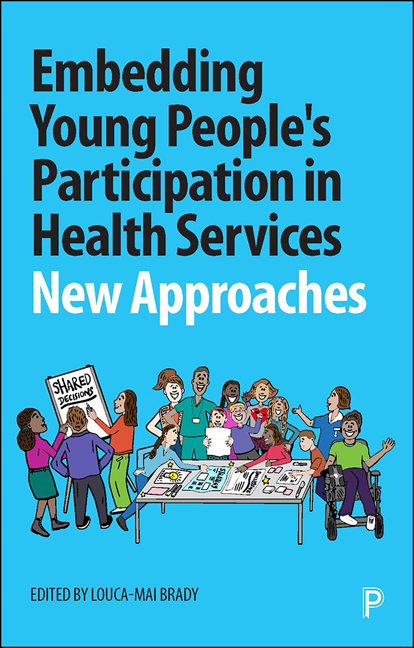Book contents
- Frontmatter
- Dedication
- Contents
- List of Boxes, Figures and Tables
- Summary
- Notes on Contributors
- Acknowledgements
- Foreword
- Introduction: Embedding Young People’s Participation in Healthcare
- PART I Young People’s Participation in Individual Decision-Making
- PART II Participation in National Projects and Programmes
- PART III Collaborative Research in NHS Services
- PART IV Young People-led Participation
- Index
1 - Shared Decision-Making with Young People in Mental Health Services
Published online by Cambridge University Press: 25 February 2021
- Frontmatter
- Dedication
- Contents
- List of Boxes, Figures and Tables
- Summary
- Notes on Contributors
- Acknowledgements
- Foreword
- Introduction: Embedding Young People’s Participation in Healthcare
- PART I Young People’s Participation in Individual Decision-Making
- PART II Participation in National Projects and Programmes
- PART III Collaborative Research in NHS Services
- PART IV Young People-led Participation
- Index
Summary
This chapter explores shared decision-making with young people about their mental healthcare. This includes:
• a foreword from a young adult with experience of using inpatient services about the meaning of shared decisionmaking;
• the constraints on shared decision-making in mental health inpatient units;
• tools and resources to support shared decision-making.
Foreword from Amy
I am not normally as candid about my personal experience as I have been in this chapter. In general, I use professional experience and the views of the young people of today. However, when I read the first draft, I found that the experiences young people of today mirror my memories of inpatient units. As I have the benefit of hindsight, it felt important to give my own experiences as a patient as part of my contribution to this chapter.
I was 16 when I first came across shared decision-making. I’d dropped out of school and work and was in and out of Child and Adolescent Mental Health (CAMHS) inpatient services like a yo-yo. Through voluntary work, I had found myself on the steering group for a Health Foundation-funded project called ‘Closing the Gap: Shared Decision Making in CAMHS’. I was sat in a room full of very highly skilled professionals, advocates and research fellows and yet I was lost. I couldn't understand what shared decisionmaking was, or what I was doing there. Despite their best efforts, no one in the room could explain the concept. I’d been battered about in the mental health system for years. Shared decision-making wasn't something I’d come across. To my mind, the professionals were the experts and they decided what happened. My doctors negotiated with my parents and I was presented with the results of this decision-making process. This made perfect sense, the doctors held the prescription pads and keys to the ward, and my parents were in charge of what I could and couldn't do at home. What on earth did ‘Shared Decision-Making’ mean? Why would anyone involve me?
The less choice I felt I had, the more I crumbled into impulsivity, with no visible modelling of rational decision-making. I felt less and less identity, more like a pawn in some tactical game of chess.
- Type
- Chapter
- Information
- Embedding Young People's Participation in Health ServicesNew Approaches, pp. 31 - 52Publisher: Bristol University PressPrint publication year: 2020
- 1
- Cited by



